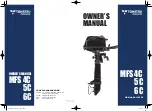
MAINTENANCE
44
The owner/operator is not to modify the engine in any manner that would alter the horsepower or allow emissions
levels to exceed their predetermined factory specifications.
Inspection And Maintenance Schedule
BEFORE EACH USE
•
Check engine oil level. See Fuel & Oil - Checking and Adding Engine Oil.
•
Check that lanyard stop switch stops the engine.
•
Visually inspect the fuel system for deterioration or leaks.
•
Check outboard for tightness on transom.
•
Check steering system for binding or loose components.
•
Remote Control Models - Visually check steering link rod fasteners for proper tightness. See Steering Link
Rod Fasteners.
•
Check propeller blades for damage.
AFTER EACH USE
•
Flush out the outboard cooling system if operating in salt or polluted water. See Flushing the Cooling System.
•
Wash off all salt deposits and flush out the exhaust outlet of the propeller and gearcase with fresh water if
operating in salt water.
EVERY 100 HOURS OF USE OR ONCE YEARLY, WHICHEVER OCCURS FIRST
•
Lubricate all lubrication points. Lubricate more frequently when used in salt water. See Lubrication Points.
•
Change engine oil and replace the oil filter. The oil should be changed more often when the engine is operated
under adverse conditions such as extended trolling. See Changing Engine Oil.
•
Replace spark plugs at first 100 hours or first year. After that, inspect spark plugs every 100 hours or once
yearly. Replace spark plugs as needed. See Spark Plug Inspection and Replacement.
•
Inspect thermostat visually for corrosion and broken spring. Make sure thermostat closes completely at room
temperature.
1.
•
Check fuel line filter for contaminants. See Fuel System.
•
Check corrosion control anodes. Check more frequently when used in salt water. See Corrosion Control
Anode.
•
Check and adjust valve clearance, if necessary.
1.
•
Drain and replace gearcase lubricant. See Gearcase Lubrication.
•
Lubricate splines on the driveshaft.
1.
•
Remote control models - Check control cable adjustments.
1.
•
Inspect timing belt. See Timing Belt Inspection.
•
Check tightness of bolts, nuts, and other fasteners.
EVERY 300 HOURS OF USE OR THREE YEARS
•
Replace water pump impeller (more often if overheating occurs or reduced water pressure is noted).
1.
BEFORE PERIODS OF STORAGE
•
Refer to Storage procedure. See Storage section.
Flushing The Cooling System - Standard Models
Flush the internal water passages of the outboard with fresh water after each use in salt, polluted, or muddy water.
This will help prevent a buildup of deposits from clogging the internal water passages.
Use a Mercury Precision or Quicksilver accessory (or equivalent) flushing attachment.
IMPORTANT: The engine must be run during flushing in order to open the thermostat and circulate water through
the water passages.
1.
These items should be serviced by an authorized dealer.












































